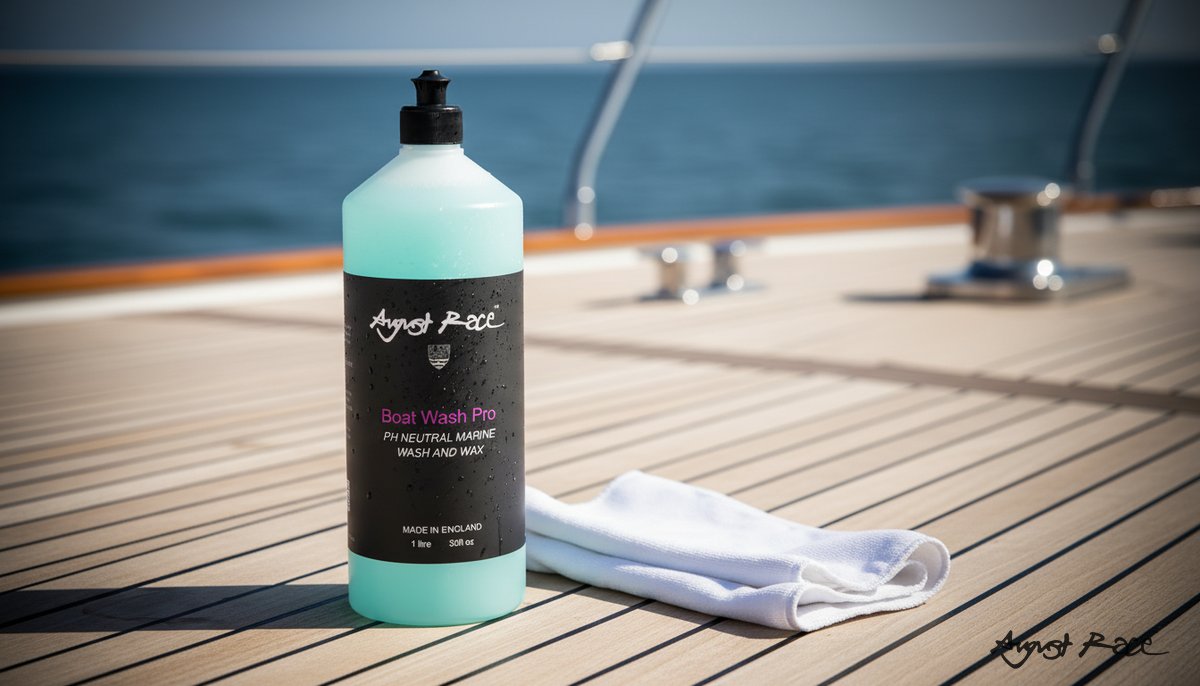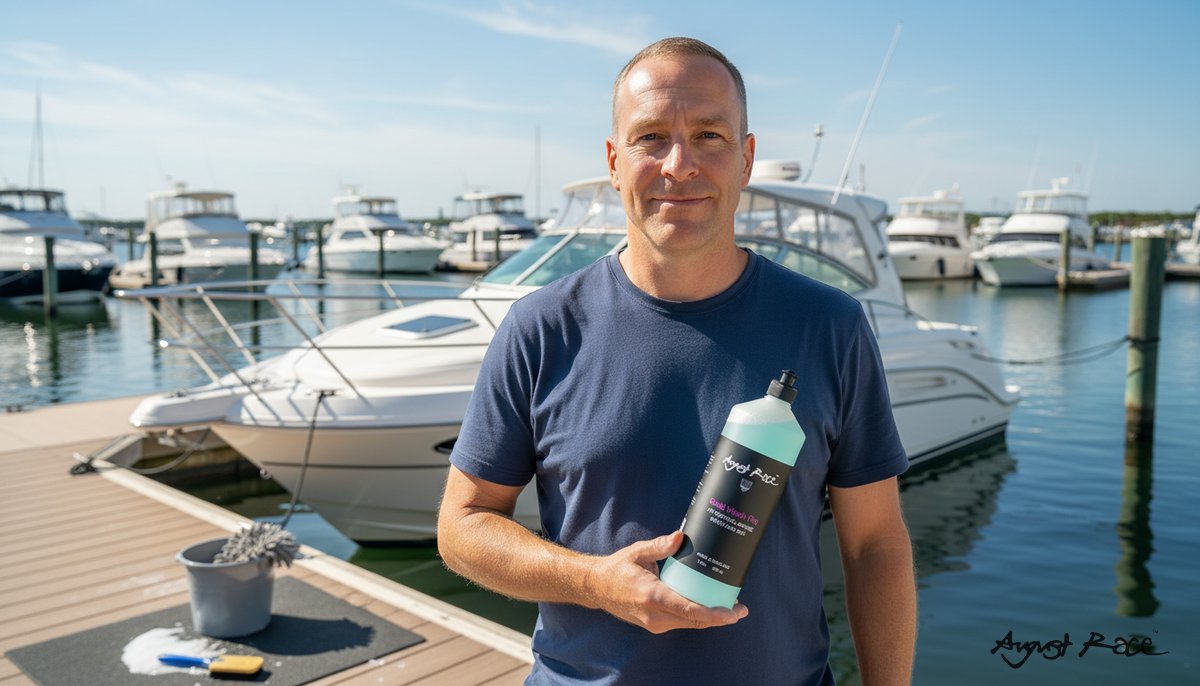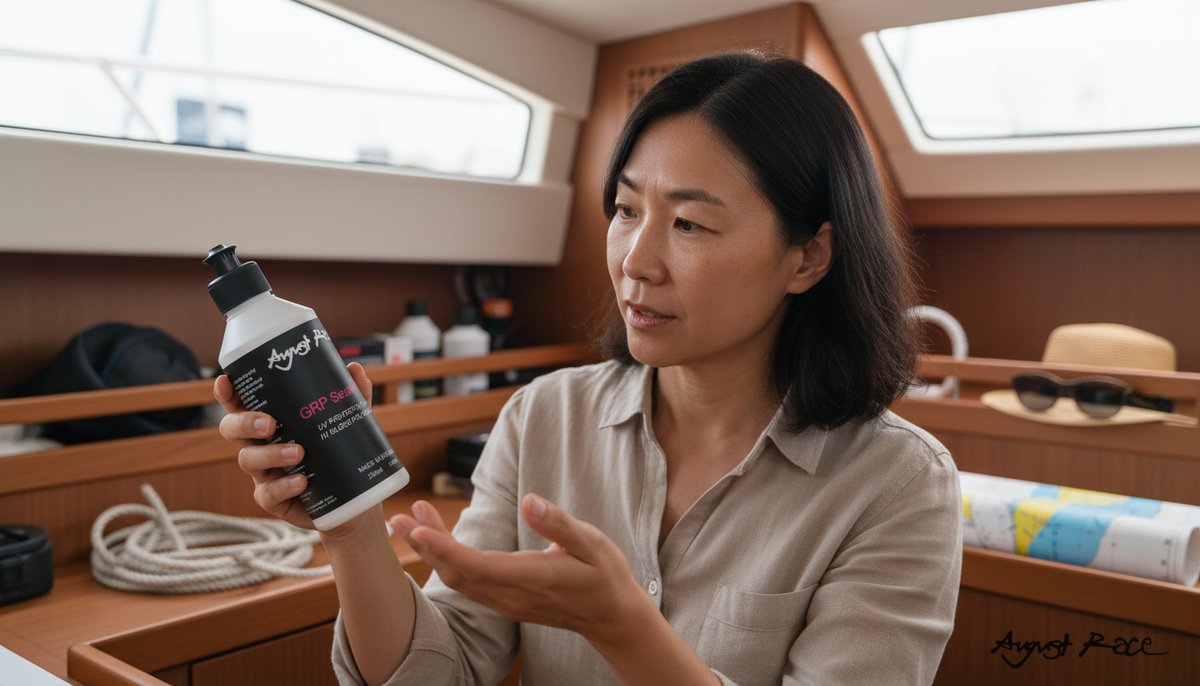How I Stopped Gelcoat Water Spots and Rain Oxidation with August Race GRP Sealer UV
Some mornings remind you that pride alone won’t protect a yacht. I stepped on deck after an overnight shower and saw a halo of gelcoat water spots tracing the rail and dull patches on the topsides. The shine I obsess over looked tired, and that sinking feeling hit: if rain keeps doing this, rain oxidation will slowly win.
I wanted a fix that matched the boat -- practical, high-end, and proven. Not a gimmick, not another weekend lost to compounding. I started looking for a fiberglass sealer that would shed water and block UV -- something closer to a true UV poly coating than a temporary wax. That search led me to August Race GRP Sealer UV. I decided to try it because it promised owner-friendly application with a prestige finish.
A morning on deck that changed how I protect my yacht
The spots were everywhere -- tiny mineral rings where droplets dried. Under the light, I could see faint hazing in a few panels, the early sign of rain oxidation nibbling at the gelcoat. It wasn’t catastrophic, but it was the first time my boat didn’t look like the investment I know it is.
I’ve always believed good care equals good value. Seeing that dullness told me I needed to be more proactive. I wanted to stop gelcoat water spots from forming in the first place and slow the UV fade that makes white hulls look chalky. That’s when I started digging into products that combine hydrophobic behavior with UV defense -- ultimately choosing August Race GRP Sealer UV as a pragmatic, prestige solution.
Why gelcoat gets water spots and how rain causes oxidation
Water spots happen when droplets dry and leave behind minerals. If your surface isn’t sealed, microscopic texture holds those deposits. Acidic rain can add its own bite. Over time, the cycle of wetting and drying bakes those marks in, especially under sun.
Then there’s rain oxidation. UV exposure weakens the top of the gelcoat. Add water, minerals, and heat, and you get haze, chalking, and loss of gloss. Many owners shrug and say, “It’s just cosmetics,” or “I’ll polish it out.” But constant polishing thins the surface and costs time. Prevention keeps the shine deeper, longer -- and helps resale.
For me, that meant a solution that ticks two boxes: it needs to shed water fast and block UV. In short, a hydrophobic fiberglass sealer with a durable UV poly coating feel. That’s the logic that led me to test August Race GRP Sealer UV.
What August Race GRP Sealer UV is -- a yacht owner’s summary
Think of it as a durable, UV‑resistant poly-style coating formulated for gelcoat and GRP. It lays down a protective, hydrophobic surface that helps water bead and roll off instead of drying into spots. It also boosts depth of gloss, so the finish looks freshly detailed.
As an owner, these points mattered:
- Hydrophobic behavior that keeps water moving off panels.
- UV protection to slow oxidation and keep color true.
- A richer, deeper shine with a professional-looking finish.
- DIY-friendly application -- no heavy equipment.
It’s designed for common gelcoat systems and aims to enhance the surface while protecting the investment. That balance of aesthetics and practicality is what sold me.
How I applied August Race GRP Sealer UV -- a DIY walkthrough
If you want DIY application for hi-gloss gelcoat protection, prep is half the result. Here’s what worked for me.
Preparation
- Wash thoroughly to remove salt, grime, and old residues. A pH-balanced cleaner like August Race Boat Wash Pro makes this step fast and effective.
- Decontaminate: on clean gelcoat, I used a light clay pass; on slightly tired areas, a mild finishing polish to level the surface. Heavy oxidation needs proper correction before sealing.
- Rinse, then dry completely. Water hiding in seams can interfere with bonding.
Application steps
-
Work in shade on a cool, dry hull. Aim for stable temperatures and good ventilation.
-
Do a small test panel first to confirm compatibility and your technique.
-
Use a clean foam applicator or soft microfiber pad. Apply a thin, even coat in overlapping passes. Less is more.
-
Watch your edges to avoid lap marks. I traced natural panel lines and rail breaks to keep sections tidy.
-
Respect the cure window on the label. Don’t rush it -- allow the coating to set before exposure to dew or spray.
-
If the product guidance allows, a very light buff with a fresh microfiber after initial flash can lift the gloss a notch and even out any faint streaks.
Coverage, timing, and tips
- I handled one hull side in logical sections -- transom, aft quarter, midships, then bow -- so I could maintain consistent overlap.
- Each section took minutes, not hours. The bottleneck is prep, not application.
- Keep several towels handy and swap often to avoid dragging residue.
- Don’t chase perfection in direct sun; shade makes everything more forgiving.
- Always follow the label for temperatures, layers, and cure times.
With that process, I got a uniform finish and the high-gloss look I wanted from a fiberglass sealer without calling in a full detailing crew.
Before-and-after results: beading, gloss, and resisting rain spots
The first sign it worked was the beading. After a quick dockside rinse, water formed tight, round droplets and ran off fast. Following a light drizzle, the topsides didn’t wear that familiar spotted film. Most droplets slid away before they could dry.
Gloss depth improved as well. Under dock lights, reflections looked crisper, with that “wet” showroom look I expect from a fresh detail. The effect was immediate, but the real test came over the next few weeks of changeable weather.
After several rain events, the treated panels resisted new gelcoat water spots far better than before. Maintenance changed from polishing out marks to a simple gentle wash. If you have heavy, etched staining, correct it prior to sealing -- the product protects moving forward; it doesn’t erase deep damage.
The owner benefit is simple: less maintenance, longer intervals between polish sessions, and a hull that holds its prestige.
Seasonal tips: preventing oxidation from rain and fall tips for sealing boat hulls
Fall is prime time to seal. You’ve got cooler temps, frequent storms, and many of us prepare for layup. Sealing now helps with preventing oxidation from rain on fiberglass while the boat sits or sees less frequent use.
My seasonal checklist
- Clean: remove salt, soot, and old wax residues.
- Decontaminate: clay or mild polish to smooth the surface.
- Seal: apply August Race GRP Sealer UV in thin, even coats.
- Inspect: after the first few rains, do a visual check for beading and touch up any high-wear spots.
Storage notes
- A breathable, well-fitted cover pairs nicely with a hydrophobic surface -- less pooling, fewer spots.
- Keep scuppers clear and fenders clean so grime doesn’t transfer to sealed panels.
Longevity and reapplication
- Expect protection to vary with exposure and washing habits. If you like a “just-detailed” gloss, you may reapply more often; if you’re pragmatic, you can extend intervals.
- Use beading as your cue: when water stops forming tight beads and starts sheeting unevenly, it’s time to refresh.
These fall tips for sealing boat hulls help lock in a high-gloss look right when rain and UV can do the most damage.

How August Race compares to other hydrophobic and UV poly coatings
Owners usually weigh four things: beading, gloss retention, durability, and ease of DIY. In my experience, August Race hits a balanced sweet spot. The water behavior rivals more complex systems, the shine is convincingly deep, and application is straightforward for a single owner working dockside.
There are trade-offs. Some multi-layer ceramics may last longer on paper, but they’re costlier and often better suited to pro application. Traditional wax is cheaper, but it fades fast and doesn’t resist rain oxidation as well. August Race sits comfortably in the middle: a prestige finish you can apply yourself with solid UV protection from a UV poly coating approach.
Choose August Race if you want high-end gloss without a workshop’s worth of tools. If your boat lives in extreme sun year-round and you want multi-year longevity with minimal upkeep, a professional two-part system may be worth considering. For most owners, this strikes the right balance of performance and practicality.
Want the same results on your yacht? Next steps to protect your gelcoat
Start small. Buy a sample bottle or treat one panel to confirm compatibility and the look you want. If you like the finish and beading, scale up section by section for DIY application for hi-gloss gelcoat protection.
You can find August Race GRP Sealer UV through the August Race shop. For larger jobs or a time crunch, a local pro can prep and apply while you handle interior projects.
Ask for a usage guide or schedule a hands-on demo if you’re new to sealers. The payoff is real: fewer gelcoat water spots, less rain oxidation, and a long-term gloss that keeps the yacht looking prestigious. That first morning on deck doesn’t have to repeat -- protecting your investment is one small, smart step away.
FAQs
Q: Is August Race GRP Sealer UV the best hydrophobic sealer for boat gelcoat spots?
A: “Best” depends on your goals, but it’s a strong choice for owners who want tight water beading, solid UV resistance, and a high-gloss finish without pro-only equipment. With proper prep, it noticeably reduces new spot formation and keeps maintenance simple.
Q: How do I prevent oxidation from rain on fiberglass during fall and winter?
A: Prep and seal before the wet season, then keep the hull rinsed and covered so water doesn’t pool and dry in place. A hydrophobic, UV‑resistant coating slows oxidation, and a quick visual check after the first few rains helps you spot areas to touch up.
Q: Can I apply August Race GRP Sealer UV myself for hi-gloss gelcoat protection?
A: Yes. Work in shade, apply thin even coats on a clean, dry surface, and follow the label’s cure times; a careful DIY job can deliver a professional-looking shine.
Q: How often should I reseal my hull to maintain water beading and UV protection?
A: It varies with climate, sun exposure, and wash routine. Reapply when beading softens and gloss fades -- often every few months in harsh conditions, or less frequently in milder use.
About the Author
Maria Chen
The Discerning Yacht Owner
Owner of a 52-foot Azimut yacht and former marine biology professor. Maria is meticulous and has become an expert in efficient and effective boat maintenance solutions through personal necessity and scientific curiosity.
Expertise:
Get Expert Tips
Subscribe for marine care insights and product updates from industry professionals.
No spam. Unsubscribe anytime.
You May Also Like

Remove Salt Buildup & Algae: Boat Wash Pro Gelcoat Care
Cut salt, lift algae, and keep gelcoat glossy with August Race Boat Wash Pro -- an easy, streak-free boat cleaning routine for yachts and RIBs.

Can faded fiberglass be restored? | August Race
Yes, faded GRP often responds to cleaning, compounding, polishing, and a UV sealer. Learn when to restore and how GRP Sealer UV protects.

Salt Removal Boat Care with August Race Boat Wash Pro
Cut saltwater stains and gelcoat grime fast. pH-neutral, biodegradable wash for fleets, RIBs, and yachts -- save rinse cycles at your marina.
